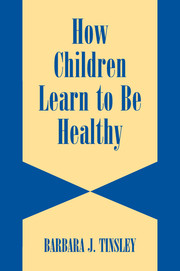Book contents
- Frontmatter
- Contents
- Acknowledgments
- How Children Learn to Be Healthy
- Introduction
- 1 Mechanisms and Consequences of Socializing Children to Be Healthy
- 2 Children's Health Understanding and Behavior
- 3 Parents' Health Beliefs
- 4 Parents' Promotion of Their Children's Health
- 5 Parents' Promotion of Their Children's Sexual Health
- 6 Peers, Schools, and Children's Health
- 7 How Television Viewing and Other Media Use Affect Children's Health
- 8 The Social Ecology of Children's Health Socialization
- 9 Summary and Conclusions
- References
- Index
8 - The Social Ecology of Children's Health Socialization
Published online by Cambridge University Press: 27 July 2009
- Frontmatter
- Contents
- Acknowledgments
- How Children Learn to Be Healthy
- Introduction
- 1 Mechanisms and Consequences of Socializing Children to Be Healthy
- 2 Children's Health Understanding and Behavior
- 3 Parents' Health Beliefs
- 4 Parents' Promotion of Their Children's Health
- 5 Parents' Promotion of Their Children's Sexual Health
- 6 Peers, Schools, and Children's Health
- 7 How Television Viewing and Other Media Use Affect Children's Health
- 8 The Social Ecology of Children's Health Socialization
- 9 Summary and Conclusions
- References
- Index
Summary
Children's health attitudes, behavior, and health status are affected by the environment in which children are reared. This environment enables or constrains child health behavior and status (Richter et al., 2000). Some aspects of this perspective on children's health have been researched; others have not. My examination of this research focuses on three issues: socioeconomic status, families' impact on the emotional climate of children's lives, and the impact of parents' health on children's health.
Socioeconomic Status
Demographic status, specifically socioeconomic status, has traditionally been the focus of efforts to describe and predict children's health (American Academy of Pediatrics, 2000a; DiLiberti, 2000; Hertzman, 1999). However, social class is not an explanatory variable, and in most cases it merely describes parents and children who vary in health attitudes, behavior, and actual health. In this book, in contrast to its traditional use, social class is conceptualized as a proxy for a broad set of environmental characteristics that may be associated with children's health socialization in health-enhancing or health-constraining conditions.
Recent statistics indicate that more children in the United States are living in poverty than in any recent period. More than one-quarter of American children under age 6 are living in poverty, although nearly three in five poor children have working parents (National Center for Children in Poverty, 1995). Adults and children of higher social class usually have access to better health services, use them more frequently, and have better health (Adler et al., 1994; Aylward, 1992).
- Type
- Chapter
- Information
- How Children Learn to be Healthy , pp. 104 - 123Publisher: Cambridge University PressPrint publication year: 2002



